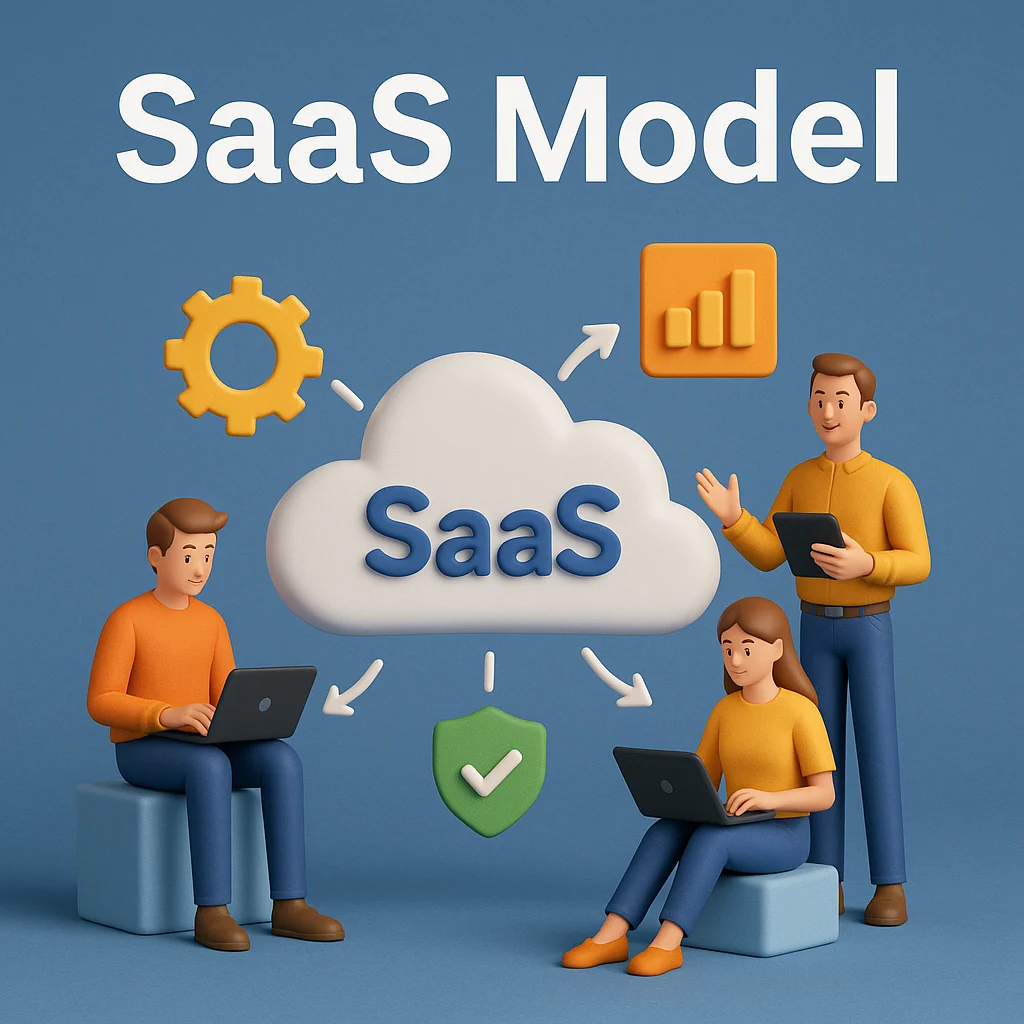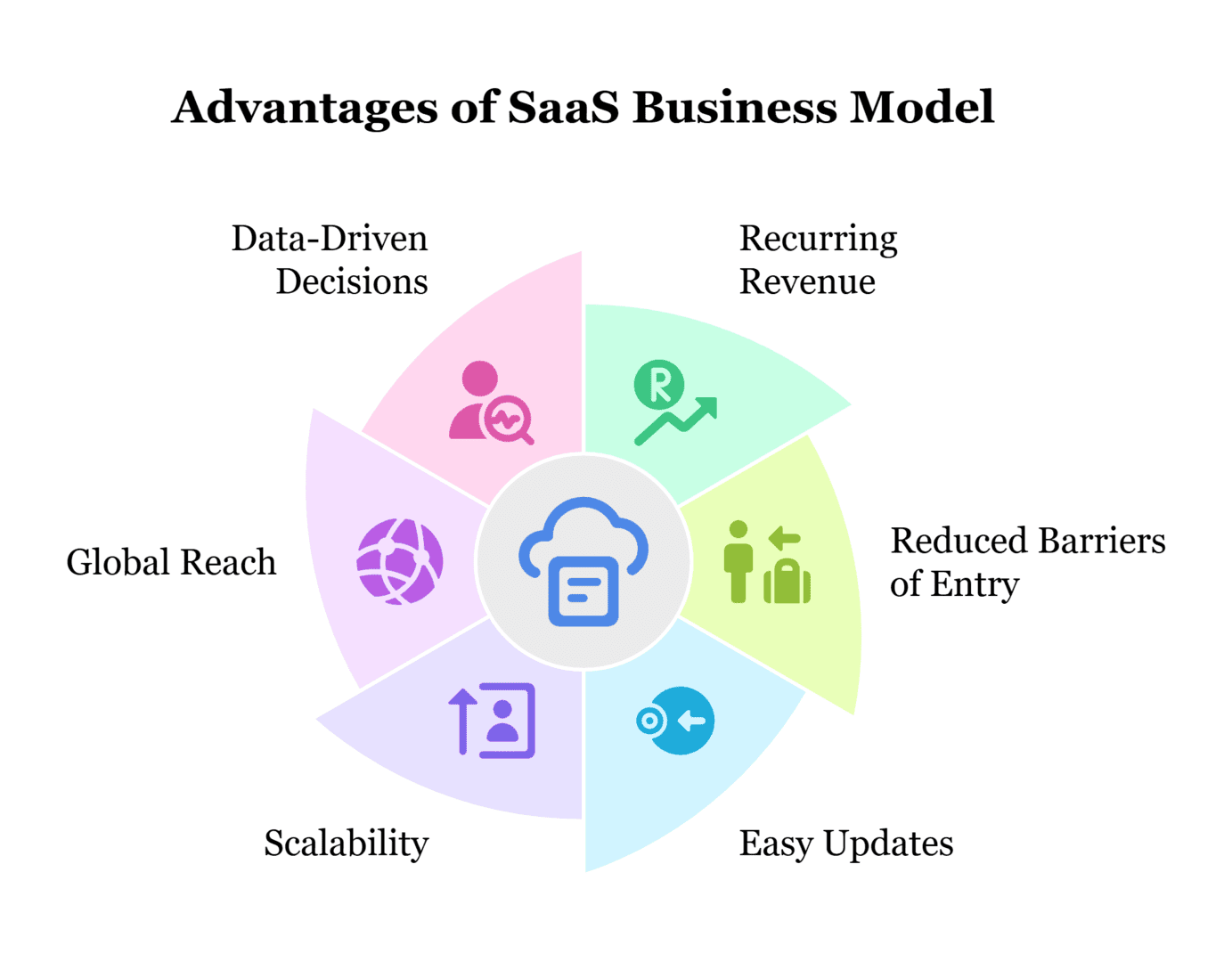What Is the SaaS Model? Benefits, Ideas & Examples
Table of Contents

Have you ever accessed apps such as Netflix, Zoom, or Canva without downloading them? It is the magic of the SaaS model, meaning Software as a Service. SaaS can be found everywhere nowadays. It will enable you to use the powerful software on the web, pay only when you use it, and avoid software installation and upgrades. What, though, is the SaaS model? What makes it popular among people and business owners? We will discuss it in the simplest terms in this blog by learning what a SaaS business is, how it works, and what advantages it has, as well as some ideas of SaaS businesses in case you are considering launching one of your own. Let us jump in!
From small startups to global enterprises, the SaaS Business Model is transforming how businesses operate, scale, and thrive. According to a recent report by The Business Research Company, the global SaaS market is projected to grow at a CAGR of 6.2% by 2028.
What is a SaaS Model?

The SaaS model is a cloud-based software delivery mechanism that allows users to access applications via the internet. Unlike traditional software that requires installation on individual machines, SaaS operates on a subscription basis and is hosted on external servers. Users pay for access and enjoy benefits like automatic updates, data storage, and remote accessibility.
This model is scalable, secure, and cost-effective, making it a preferred choice for modern businesses.
Features of the SaaS Model
The features of SaaS technology set it apart from traditional software solutions:
- Subscription Pricing: No large upfront costs; pay as you go.
- Accessibility: Work from anywhere with an internet connection.
- Automatic Updates: Providers handle upgrades and bug fixes seamlessly.
- Scalability: Add users or features as your business grows.
- Integration: Easily connects with other tools via APIs.
These features make the SaaS model particularly attractive to businesses seeking agility and growth.
What is a SaaS Business?
A SaaS business provides software solutions through a subscription-based pricing model. Instead of purchasing a one-time licence, customers pay recurring fees, making it more affordable and flexible. SaaS businesses cater to industries ranging from finance and healthcare to retail and education.
For example, Salesforce (CRM) and Google Workspace (productivity tools) are prime illustrations of what a SaaS business is.
Benefits of SaaS Business Model
What are the best advantages of the SaaS business model, unless you use it or intend to create your own SaaS business? Let us have a look at them.

- Recurring Revenue
Predictable monthly income is one of the largest merits of SaaS companies. Cash flow is ensured because subscribers are on a regular payment schedule.
- Reduced Barriers to Entry
The customers will not have to part with a lot of money at once. They can subscribe to the service at 499 rupees a month as opposed to purchasing software at thousands of rupees.
- Easy Updates
The developers can update SaaS software immediately. Customers never feel the need to reinstall the same thing to have up-to-date features.
- Scalability
Since the construction of a SaaS platform is rather solid, an increase of 100 users or a 1-million-user increase will cost practically nothing.
- Global Reach
SaaS is an online platform, and thus it can be sold all over the world. Where you live does not restrict you.
- Data-Driven Decisions
A majority of SaaS tools gather usage information. This assists founders to a better user experience and customization of features depending on user behavior.
The Role of SaaS in Scaling Business Operations
Scaling a business involves increasing capacity, productivity, and profitability without compromising quality. Here’s how the SaaS model facilitates seamless growth:
- Flexibility and Scalability
The SaaS model allows businesses to expand their operations without hefty infrastructure investments. Whether you’re adding new users or upgrading features, SaaS platforms adapt effortlessly.
- Cost Efficiency
With no hardware or maintenance costs, businesses save significantly. Subscriptions spread costs over time, offering predictable expenses and reducing financial strain.
- Global Accessibility
SaaS products operate in the cloud, making them accessible to teams worldwide. Employees can collaborate from anywhere, enhancing productivity.
- Continuous Innovation
SaaS providers roll out regular updates, ensuring users always access the latest technology without disruption.
SaaS Business Applications Across Industries
The adaptability of the SaaS Business Model has led to its adoption across diverse industries.
- Finance and Accounting: Tools like QuickBooks streamline bookkeeping and payroll management.
- Marketing: Platforms like HubSpot enable marketing automation and lead generation.
- Healthcare: SaaS solutions manage patient records, appointments, and diagnostics securely.
- E-Commerce: Shopify empowers businesses to set up online stores with ease.
- Education: Learning management systems (LMS) like Moodle support virtual classrooms.
SaaS Business Ideas for Entrepreneurs
With the demand for SaaS growing, countless opportunities await budding entrepreneurs.
- Niche Market SaaS: Develop a product tailored to a specific industry, such as law firm management.
- AI-Powered SaaS: Integrate AI to automate customer support or analyze big data.
- Collaborative Tools: Create platforms for remote teams, such as project management or video conferencing apps.
- Subscription-Based Analytics: Build a SaaS product focused on providing businesses with actionable insights.
By tapping into these SaaS business ideas, entrepreneurs can create products that solve pressing business challenges.
What is a SaaS Product?
A SaaS product is a cloud-based application designed to solve specific business needs. Examples include Slack for communication, Zoom for virtual meetings, and Shopify for e-commerce. These products are often customizable, scalable, and easy to integrate into existing workflows.
Advantages of SaaS Products
The rise of SaaS is no coincidence—its advantages are undeniable:
- Cost-Effective: Eliminates the need for infrastructure.
- Time-Saving: Quick deployment and minimal downtime.
- Enhanced Collaboration: Enables team interaction regardless of location.
- Customizable: SaaS products often offer tailored solutions.
Is Netflix a SaaS Model?
Yes, Netflix aligns with the SaaS model. It operates as a subscription-based service delivering video content over the cloud. However, its primary focus is entertainment rather than productivity.
Similarly, is YouTube a SaaS? Not quite. While YouTube Premium has SaaS-like elements, the platform primarily functions as a content-sharing service rather than a traditional SaaS product.
Conclusion
The SaaS model has revolutionized business operations by providing flexible, affordable, and scalable solutions. From fostering collaboration to enabling global accessibility, its benefits are undeniable. As more industries embrace SaaS, its role in driving innovation and efficiency will only grow.
Whether you’re exploring SaaS business ideas or adopting new SaaS Business Applications, the opportunities are endless. Now is the time to harness the power of SaaS and elevate your business operations to the next level.
Frequently Asked Questions
What is a SaaS model in simple terms?
The SaaS model, or Software as a Service, is a way to deliver software online. Instead of buying and installing it, users access the software via the internet and pay a subscription fee (monthly or annually).
How does a SaaS business make money?
SaaS businesses earn through subscription fees, premium features (freemium model), tiered pricing, enterprise solutions, and sometimes advertising or usage-based billing.
What are the benefits of the SaaS model?
Key benefits include recurring revenue, easy scalability, instant software updates, low upfront costs for users, and a global customer reach.
What are examples of SaaS businesses?
Popular SaaS companies include Netflix, Canva, Google Workspace, Zoom, Salesforce, and Dropbox — all offer services via the cloud without requiring local installation.
Is SaaS the same as cloud computing?
Not exactly. SaaS is a type of cloud computing. While cloud computing includes infrastructure (IaaS) and platforms (PaaS), SaaS focuses specifically on delivering software applications over the internet.


















1 thought on “SaaS Models Exposed: Features, Benefits, And Opportunities”
Insightful overview of SaaS models for businesses! The breakdown of benefits and strategies is highly informative. Thanks for sharing this resource!